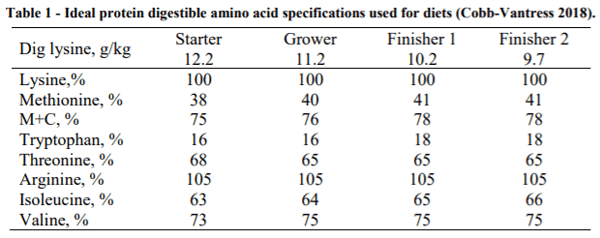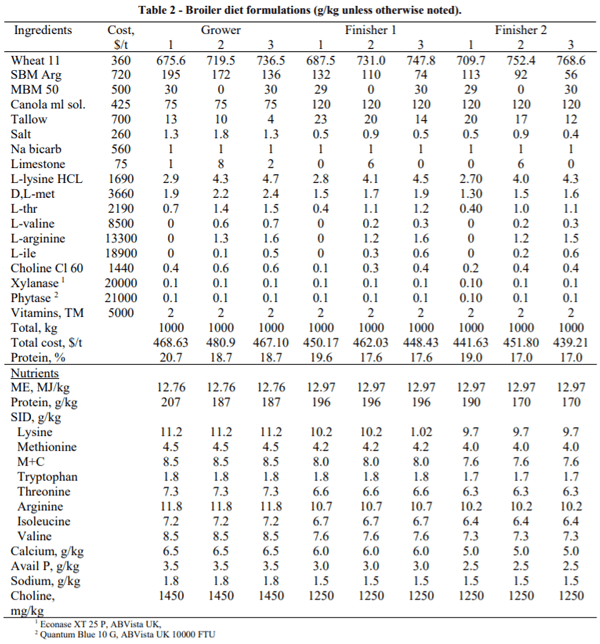Economics of Low Protein Broiler Diets: A Formulation Exercise
This paper investigates the costs of wheat-based broiler diets with twenty g/kg lower protein than current through a formulation exercise. In the context of this exercise, this means protein of 187, 176 and 170 g/kg for grower, finisher 1 and finisher 2, respectively. Current prices of valine, arginine and isoleucine would allow these lower protein diets to be formulated at $10-12/t higher priced than their unrestricted protein comparisons. It was found that valine, arginine and isoleucine prices would need to be reduced by around 50% to be able to formulate these lower protein diets at costs similar to the high protein ones. The effects of formulating and producing lower protein diets would mean large increases in lysine, methionine and threonine usage; the use of valine, arginine and isoleucine, higher levels of wheat, lower levels of added oil, and lower levels of soybean meal. It is suggested that at some point commercial broiler companies may try these lower protein diets to investigate potential benefits on performance, litter quality and odour remediation, starting with finisher 2.



Baker D & Han Y (1994) Poultry Science 73: 1441-1447.
Cobb 500 Broiler Performance and Nutrition Supplement (2018) Cobb-Vantress L-2114-08 EN: April 2018.
Dean DW, Binder TD & Southern LL (2006) Poultry Science 85: 288-296.
Drew MD, Syed NA, Goldale BG, Laarveld B & van Kessel AG (2004) Poultry Science 83: 414-420.
Edmonds MS, Parsons CM & Baker DH (1985) Poultry Science 64: 1519-1526.
Garland PW (2018) Proceedings of the Australian Poultry Science Symposium 29: 1-7.
Gordon RS & Sizer IW (1955) Poultry Science 122: 1270-1271.
Hilliar M & Swick RA (2018) Proceedings of the Australian Poultry Science Symposium 29: 8-11.
Hilliar M, Morgan N, Hargreave G, Barekatain R, Wu S & Swick RA (2017) Proceedings of the Australian Poultry Science Symposium 28: 158.
Kidd MT & Choct M (2017) Proceedings of the Australian Poultry Science Symposium 28: 175.
Lambert W & Corrent E (2018) Proceedings of the Australian Poultry Science Symposium 29: 20-27.
Sharma NK, Choct M, Dunlop MW, Wu SB, Castada H & Swick RA (2016) Poultry Science 96: 851-860.
Waldroup PW & Harms RH (1963) Poultry Science 42: 652-657.


The prices are a moving target. But yes that paper is AUD not Euros.
We can say that as time goes by, the purified AA sources will likely get cheaper as demand picks up and economy of scale is realised. The next thing to be considered will be sustainability.
On first thought, most will think purified sources will be more sustainable than SBM. However one needs to consider the input materials to produce purified AA sources including water, starch, sugar, nitrogen and electricity for maintaining fermentation temperature and drying the final product. Methionine is truly synthetic being made from petroleum derived chemicals methyl mercaptan, acrolein and hydrogen cyanide (and petroleum is not very sustainable).
Soybeans are grown on farms using varying degrees of sustainable practices. But they do employ rural people and put more nitrogen into the soil than they take away. The amino acids produced by soybeans use nitrogen fixed from the air. When produced in situations where they do not impact important natural habitats they are truly a highly sustainable miracle crop.



E.S.E. & INTEC

Robert Swick, consistent with the report by Mr George Entz, research work that we conducted with broiler chicken, the results of which are published here at ENGORMIX, under the title: Digestible lysine levels obtained by two methods of formulation of diets for 22- to-42-day-old broilers confirm that diets with a full protein level provide better performance results for broilers.










